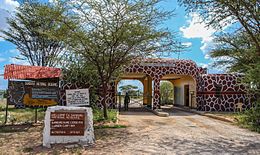Samburu National Reserve
| Samburu National Reserve | |
|---|---|
 Entrance | |
| Location | Kenya, Samburu County |
| Coordinates | 0°37′5″N 37°31′48″E / 0.61806°N 37.53000°E |
| Area | 165 km2 (64 sq mi) |
| Established | 1985 |

The Samburu National Reserve is a game reserve on the banks of the Ewaso Ng'iro river in Kenya. On the other side of the river is the Buffalo Springs National Reserve. The park is 165 km² in size and is situated 350 kilometers from Nairobi. It ranges in altitude from 800 to 1230 m above sea level.[1] Geographically and administratively, it is part of Samburu County.
In the middle of the reserve, the
The Samburu National Reserve was one of the two areas in which conservationists
The Samburu National Reserve is also the home of Kamunyak, a lioness famous for adopting oryx calves.
Habitat
Samburu National Reserve contains two mountains, Koitogor and Ololokwe, and the Ewaso Ng'iro river (meaning "brown water") that runs through it and the mixture of acacia, riverine forest, thorn trees and grassland vegetation. The Ewaso Ng'iro flows from the Kenyan highlands and empties into the famous Lorian Swamp. The natural serenity that is evident here is due to its distance from industry and the inaccessibility of the reserve for many years.
Wildlife

There is a wide variety of animal and bird life seen at Samburu National Reserve. Several large game species common to Kenya's northern plains can be found in abundance here, including the following dry-country fauna:
Other mammals frequently seen in the park include
There are over 350 species of bird. These include
The Ewaso Ng'iro river contains large numbers of Nile crocodile basks.[4]
Since 2005, the protected area is considered part of a
See also
References
- ^ http://www.kenya.me.uk Facts about the Samburu National Reserve
- ^ Jackman, Brian. "BBC - Big cat watching in Africa". www.bbc.co.uk. Archived from the original on August 4, 2007. Retrieved 2008-03-17.
- ^ "Rhinos return to Samburu". Save The Rhino. Retrieved 2020-03-03.
- ^ "Three lions fight crocodiles for food". stormmark.com. Retrieved 2014-08-21.
- ^ IUCN Cat Specialist Group (2006). Conservation Strategy for the Lion Panthera leo in Eastern and Southern Africa. Pretoria, South Africa: IUCN.

